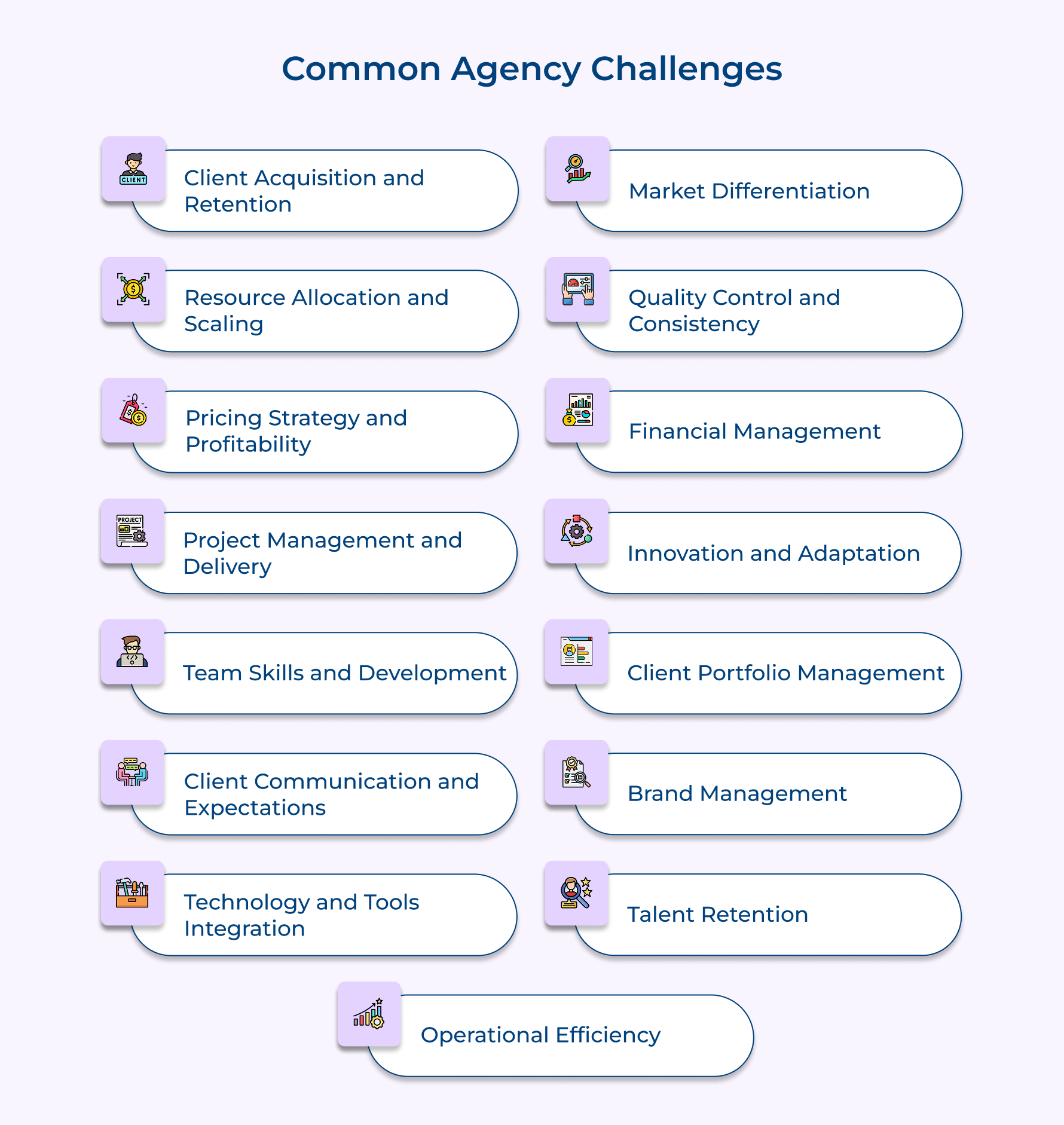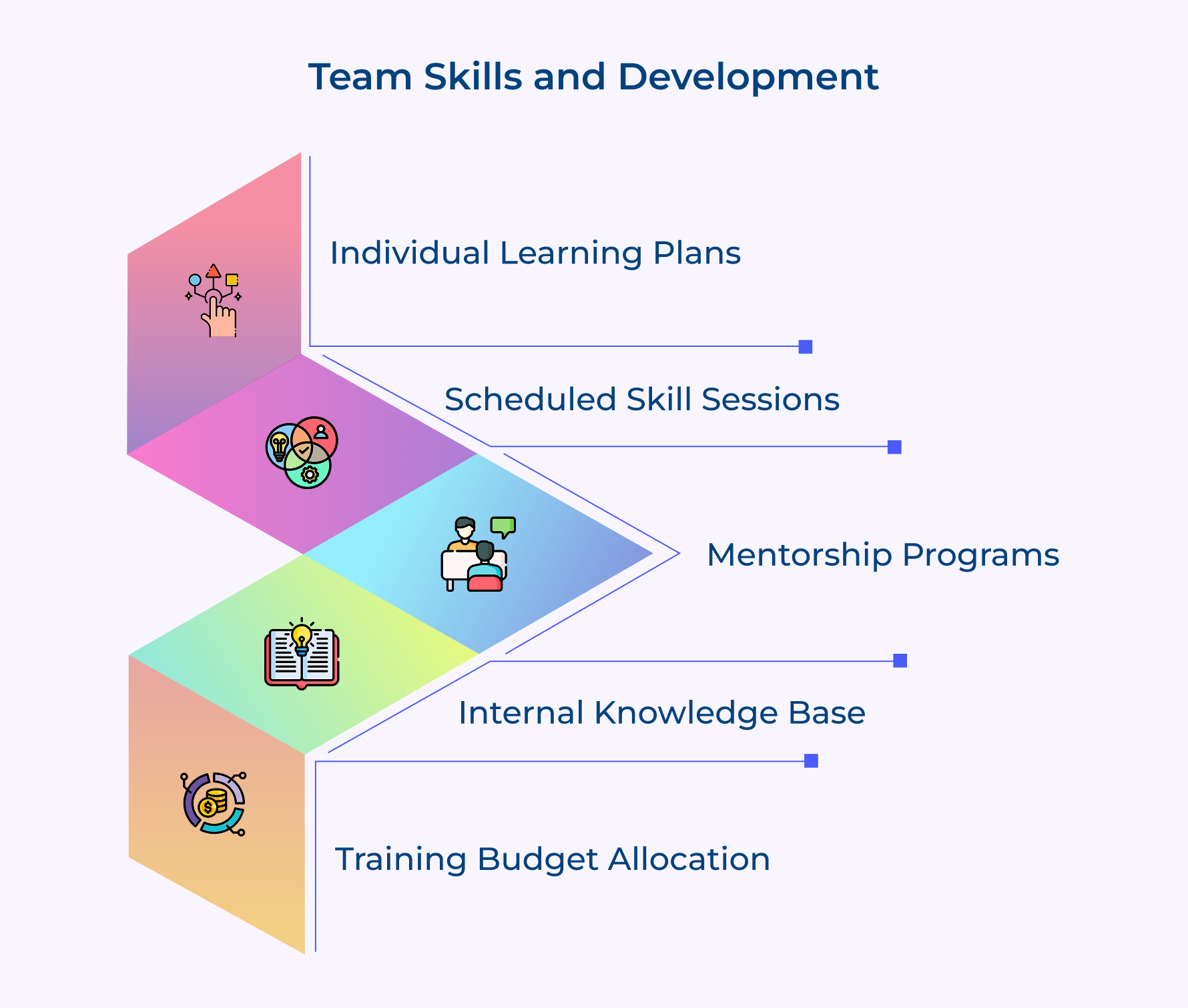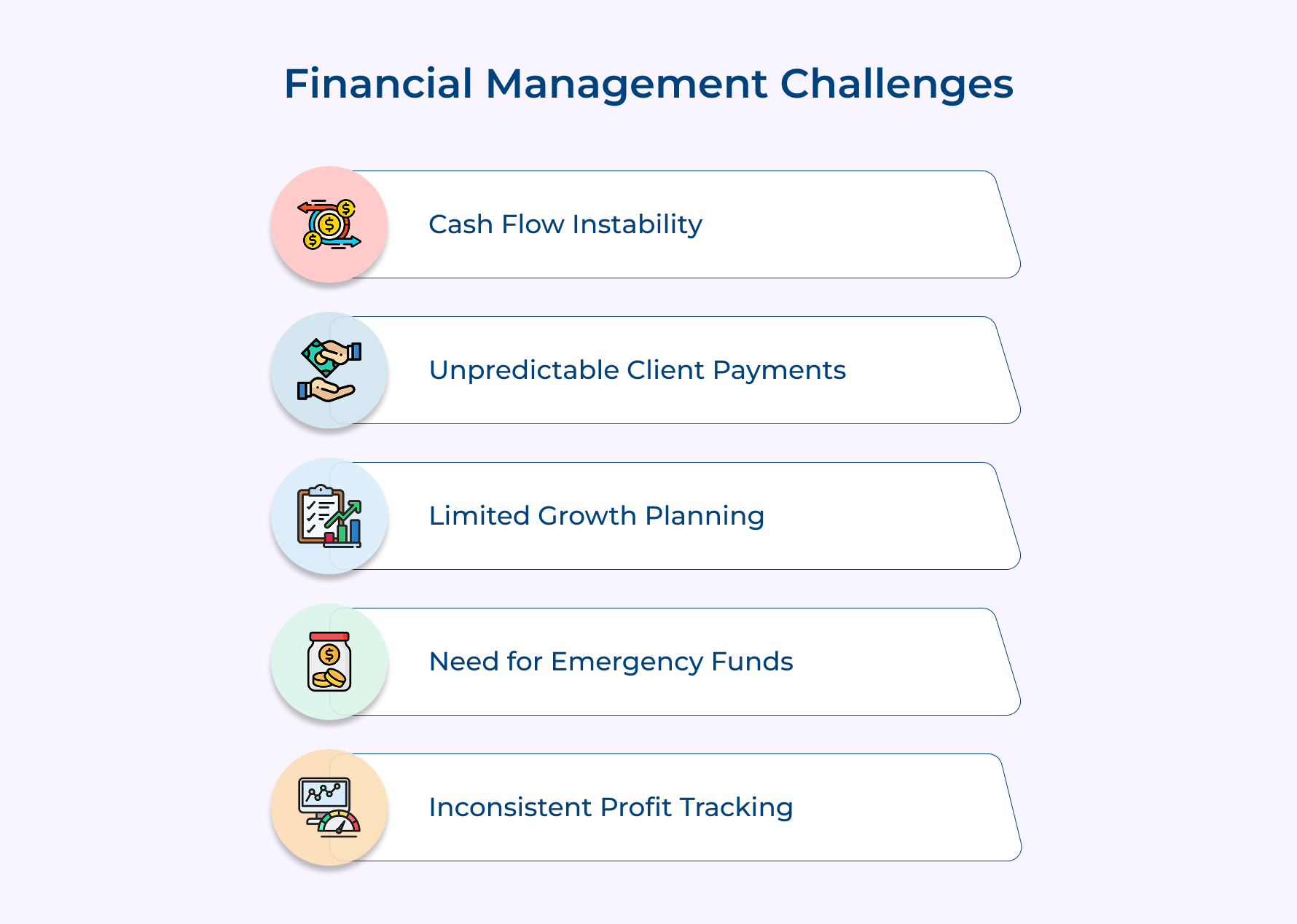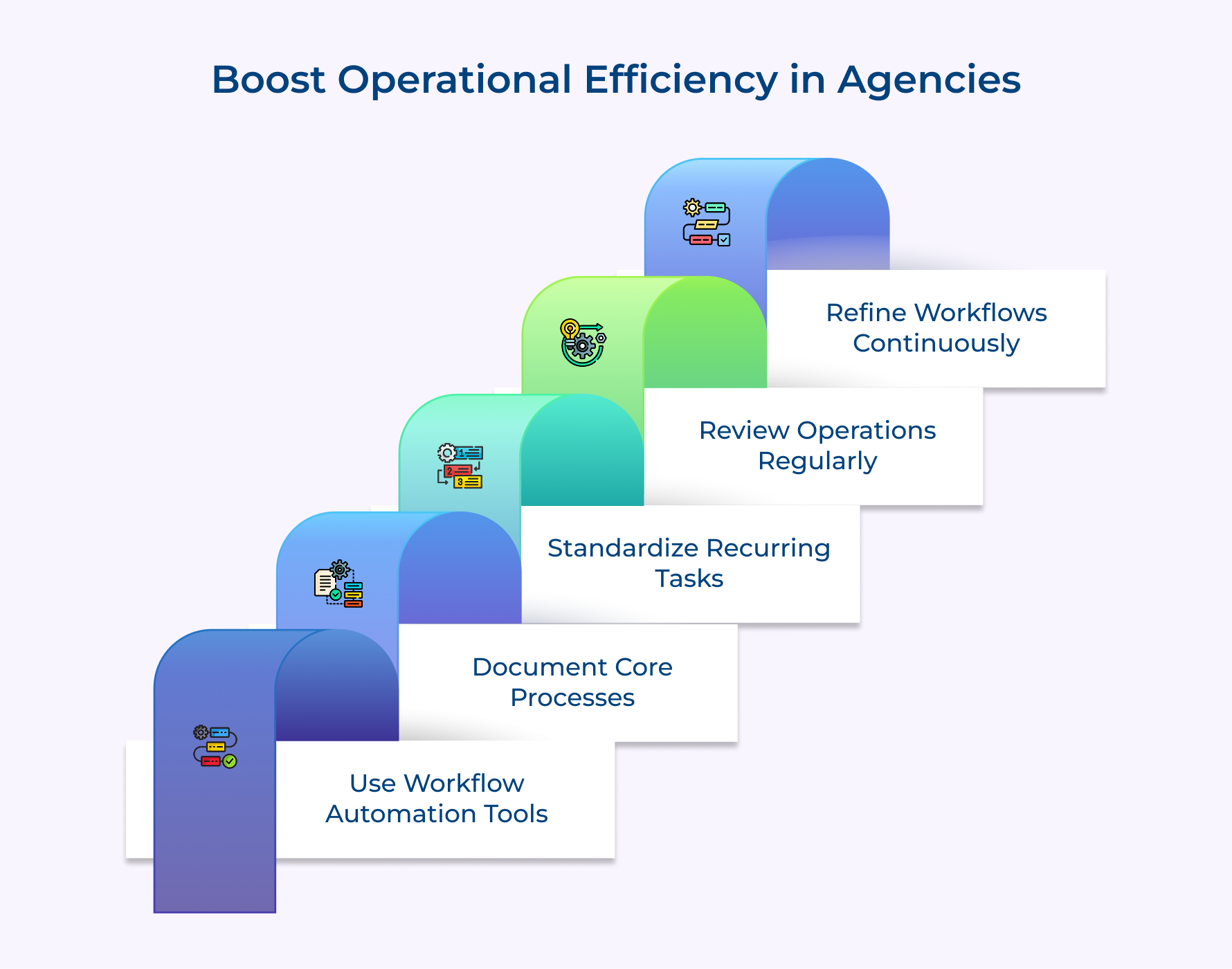15 Agency Challenges and Ways to Deal with Them

Key Highlights:
- Navigating agency challenges requires strategic planning to balance workload and client demands while ensuring team development and maintaining consistent quality.
- Streamlining operations without sacrificing creativity is key to improving efficiency and profitability.
- Developing robust systems for resource management and client communication ensures better project outcomes.
The agency world is transforming at breakneck speed. What worked yesterday might not cut it tomorrow, and staying competitive requires more than just delivering great work.
As agencies navigate through shifting client expectations, digital transformation, and talent management hurdles, the need for adaptive strategies has never been more critical.
Let’s dive deep into the core agency challenges and explore practical solutions that can help transform these obstacles into opportunities for growth.
15 Agency Challenges and How to Deal with Them
Running an agency comes with unique as well as common challenges, from client management to scaling operations. Here are 15 common issues and practical solutions to tackle them.
1. Client Acquisition and Retention
Agencies struggle with maintaining a steady flow of new clients while retaining existing ones in an increasingly competitive space. The challenge involves balancing resource allocation between pursuing new business opportunities and servicing current clients, all while dealing with market saturation as well as evolving client expectations.
How does it impact?
- Unstable revenue streams lead to cash flow issues and difficulty in long-term planning.
- Increased pressure on team resources, potentially compromising the quality of deliverables.
Strategic Solutions:
- Implement a structured referral program with existing clients, offering incentives for successful referrals while developing case studies and success metrics to showcase expertise.
- Create tiered service packages with clear value propositions, including regular strategy reviews and quarterly planning sessions.
- Develop a customer success program focusing on proactive communication and early issue identification.
2. Resource Allocation and Scaling
Balancing staff capacity across multiple client projects while maintaining quality and profitability poses significant challenges. Agencies often struggle with deciding when to hire new talent versus outsourcing and how to maintain optimal utilization rates without burning out team members.
How does it impact?
- Decreased project quality due to overextended teams and resource constraints.
- Reduced profitability from inefficient resource allocation and emergency hiring.
Strategic Solutions:
- Implement resource management software with capacity planning features and establish clear utilization targets.
- Build a reliable freelancer network with pre-vetted professionals for specific skill sets.
- Create standardized onboarding and training processes to integrate new team members.
3. Pricing Strategy and Profitability
One of the biggest agency challenges for creative agencies as well as digital agencies is figuring out the right pricing. Agency owners need a model that reflects their value while staying competitive and profitable—without scaring off clients with tight budgets.
How does it impact?
- Reduced margins due to underpricing or scope creep.
- Loss of potential clients due to misaligned pricing strategies.
Strategic Solutions:
- Develop value-based pricing models with clear deliverables and success metrics.
- Implement project profitability tracking systems and regular financial health checks.
- Create modular service packages allowing for customization while maintaining profitability.
4. Project Management and Delivery
Juggling multiple client projects while keeping quality high and hitting deadlines is no easy task. With different teams, shifting client expectations, and last-minute changes, agency owners need solid systems to keep everything on track.
How does it impact?
- Missed deadlines and quality issues affecting client satisfaction.
- Increased stress on project managers and team members.
Strategic Solutions:
- Implement standardized project management methodologies with clear milestone tracking.
- Establish buffer times in project timelines and create contingency plans for common issues.
- Develop clear communication protocols and status reporting systems.
5. Team Skills and Development
Be it advertising agencies or digital marketing agencies, keeping up with industry trends as well as tech while managing client work is tough. Balancing training, billable hours, and strong relationships with clients takes strategy as well as smart planning.
How does it impact?
- Reduced competitive advantage due to outdated skill sets.
- Higher turnover rates due to lack of growth opportunities.
Strategic Solutions:
- Create individual development plans with dedicated learning time and skill-sharing sessions.
- Establish mentorship programs and internal knowledge bases.
- Allocate budget for regular training and certification programs.
6. Client Communication and Expectations
Keeping clients happy while juggling multiple stakeholders and clear communication is a constant challenge. Agencies need to stay responsive without letting endless requests or scope creep derail productivity.
How does it impact?
- Strained client relationships due to misaligned expectations.
- Increased project costs from unnecessary meetings and revisions.
Strategic Solutions:
- Implement structured communication protocols with defined response times and channels.
- Create detailed service-level agreements with clear deliverables and boundaries.
- Develop client education programs and onboarding materials.
7. Technology and Tools Integration
Choosing the right tech stack, from project management software to client tools, is a big challenge for agencies. The key is finding potential solutions that balance cost, functionality, and team adoption while keeping everything running smoothly.
How does it impact?
- Reduced efficiency due to fragmented or incompatible systems.
- Increased costs from unused or underutilized tools.
Strategic Solutions:
- Conduct regular technology audits and maintain documented integration strategies.
- Create standardized tool stacks with clear usage guidelines and training.
- Establish technology budgets with regular ROI reviews.
8. Market Differentiation
Standing out in a crowded market while maintaining a unique value proposition becomes increasingly difficult. Agencies struggle to differentiate their services and communicate their unique benefits effectively to potential clients.
How does it impact?
- Reduced win rates in competitive pitches.
- Pressure on pricing due to perceived commoditization.
Strategic Solutions:
- Develop niche expertise in specific industries or services with thought leadership content.
- Create unique service offerings combining different expertise areas.
- Implement case study programs showcasing innovative solutions.
9. Quality Control and Consistency
Delivering top-notch work across multiple projects and team members is a constant struggle. Agencies need solid processes to maintain quality without slowing things down.
How does it impact?
- Inconsistent client experiences affecting reputation.
- Increased revision cycles and resource waste.
Strategic Solutions:
- Implement quality assurance checklists and review processes for all deliverables.
- Create standardized templates and guidelines for common deliverables.
- Establish peer review systems and regular quality audits.
10. Financial Management
Managing cash flow, profitability, and financial planning while dealing with variable client payments as well as project timelines creates significant hurdles. Agencies must balance investments in growth with maintaining healthy finances.
How does it impact?
- Cash flow issues affecting operational stability.
- Difficulty in planning for growth and expansion.
Strategic Solutions:
- Implement robust financial tracking systems with regular forecasting.
- Create clear payment terms and follow-up procedures for clients.
- Establish emergency funds and credit lines for stability.
11. Innovation and Adaptation
Keeping up with industry trends while delivering top-quality service is a tough balance for agencies. With shifting market conditions, they must innovate without overwhelming clients or disrupting workflows.
How does it impact?
- Risk of becoming outdated in service offerings.
- Missed expansion opportunities.
Strategic Solutions:
- Create innovation teams with dedicated time for research and development.
- Establish partnerships with technology providers and industry leaders.
- Implement regular market analysis and trend monitoring systems.
12. Client Portfolio Management
Handling a mix of clients while giving each one the attention they need is a tricky balancing act. Agencies must manage resources wisely and avoid relying too much on just a few big accounts.
How does it impact?
- Risk exposure from the concentrated client base.
- Resource allocation challenges across varying client needs.
Strategic Solutions:
- Develop client classification systems with clear service level agreements.
- Create account management plans for key clients.
- Implement regular portfolio reviews and risk assessments.
13. Brand Management
Maintaining and evolving the agency’s brand while ensuring consistency across all touchpoints presents ongoing challenges. Agencies must practice what they preach while managing limited internal resources.
How does it impact?
- Reduced market perception affecting new business opportunities.
- Inconsistent brand experience affecting credibility.
Strategic Solutions:
- Create comprehensive brand guidelines with regular updates.
- Establish internal brand champions and review processes.
- Implement content calendars and social media strategies.
14. Talent Retention
Keeping top talent excited and motivated can be tough, especially when you’re balancing workloads as well as career growth. Agencies have to compete with both client-side roles and other firms to keep their best people engaged.
How does it impact?
- Loss of institutional knowledge and client relationships.
- Increased costs from recruitment and training.
Strategic Solutions:
- Develop clear career paths and growth opportunities.
- Create comprehensive benefits packages, including flexibility and learning.
- Implement regular feedback and recognition programs.
15. Operational Efficiency
Finding the sweet spot between streamlining operations and keeping creativity high is no easy feat. Agencies need to standardize where they can but also leave room for that creative spark without sacrificing quality.
How does it impact?
- Reduced profitability from inefficient processes.
- Increased team stress from unnecessary complexity.
Strategic Solutions:
- Implement workflow automation tools and process documentation.
- Create standard operating procedures for common tasks.
- Establish regular operational reviews and improvement cycles.
Concluding Insights: Turning Agency Challenges into Opportunities
Tackling agency challenges calls for a smart mix of innovation, efficiency, and adaptability. It’s about evolving past old-school problem-solving and finding fresh ways to grow.
By implementing solid systems for resource management, clear client communication, creative excellence, and team development, agencies can turn obstacles into growth opportunities.
Proactive planning, flexibility, and a culture of continuous improvement empowers agencies to not only navigate tough times—they can thrive in a fast-changing industry.
Limit time — not creativity
Everything you need for customer support, marketing & sales.
Neeti Singh is a passionate content writer at Kooper, where he transforms complex concepts into clear, engaging and actionable content. With a keen eye for detail and a love for technology, Tushar Joshi crafts blog posts, guides and articles that help readers navigate the fast-evolving world of software solutions.



